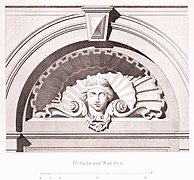Gertraudenhospital (Berlin)
| Gertraudenhospital (Berlin) | |
|---|---|
| Sponsorship | Vivantes |
| place | Berlin-Kreuzberg |
| state | Berlin |
| Country | Germany |
| Coordinates | 52 ° 29 '45 " N , 13 ° 22' 59" E |
| areas of expertise | General medicine |
| Affiliation |
Hospital Am Urban until 2001 |
| founding | 1870s |
| resolution | 2002 |
| Website | no |
The former Gertraudenhospital (also Gertraudten Hospital ) at Wartenburgstrasse 1 at the corner of Großbeerenstrasse in the Berlin district of Kreuzberg is a listed brick building with several wings and a park-like front garden from the 1870s. Originally laid out around 1406 as a hospital for destitute sick citizens in Berlin-Mitte , the house, which was moved to Kreuzberg in 1872, came under the administration of the Am Urban Hospital in 1945 . After it was sold at the beginning of the 21st century, it was designed by the Berlin architects Stephan Höhne while preserving the preservation aspects converted into a residential park with 103 condominiums and two commercial units.
St. Gertrauden-Stift and Spittelmarkt
In the historical Cölln Feldmark the St. Gertrauden pen built in 1400 before the Gertraudentor the Berlin city wall on later so named Spittelmarkt a house with a chapel for noble virgins, the later Hospital for destitute and sick citizens found a use. The Spittelkirche emerged from the chapel . The rapid expansion of the streets in Berlin during the early days of the founding left the monastery no space, so that the Gertrauden Hospital and its chapel were relocated to today's Kreuzberg Wartenburgstrasse in 1872. The most valuable pieces of equipment from the Spittelkirche, which was torn down in 1881, were moved to the new Kreuzberg hospital chapel .
The names Spittelmarkt and Spittelkirche are derived from the Gertrauden Hospital (Hospital = 'Spital' = 'Spittel'). The name Gertraude, in turn, recalls the great-great-great-aunt of Charlemagne Geretrudis , Saint Gertrud , who lived around 650 as abbess in the Walloon monastery of Nivelles and as the patroness of hospitals and gardeners, the poor and widows, pilgrims, and prisoners Traveler applies.
The original hospital was very dilapidated around 1650, was demolished and rebuilt by 1655. In connection with the rapid expansion of Berlin , plans for a total renovation of the Spittelmarkt were published in the 1810s. The buildings on it and in the vicinity had to be demolished for this, including the hospital, which was closed in 1872.
New building in Kreuzberg from the 1870s
The architect Friedrich Koch took care of the new hospital building in a completely new location on the 8,500 m² property. In a first phase between 1871 and 1873, the main building with three wings and a park-like front garden, which has been protected as a garden monument since the 1990s, was erected . In the second construction phase in 1883 and 1884, Koch laid two elongated wings standing at right angles to one another behind the central building. The 100 rooms, each around 17 m² in size, offered accommodation to 144 old women. In addition to the apartment, they received a monthly cash allowance, free heating and free medical care. The main building also accommodated the required administrative and common rooms, including the two-story chapel on the first floor.
Just as with the castle-like extensions to the Moabit brewhouse , which, according to his plans, had been completed a year earlier in 1871, Koch used elongated yellow brick facades as a style-defining architectural element . Figure friezes , narrow pilaster strips and high arched windows loosen the fronts of the main building . The side parts close to Wartenburgstraße with apse-like porches ( exedra ), which are decorated with decorated columns, ornaments and other figure friezes. In the architectural sketchbook , born in 1886, various architectural elements are recorded in detail, such as friezes of the exedra, banisters or artistic roof structures (see illustration below right). In 1910, the urban planning inspector Fritz Haack carried out modifications and small extensions.
In the front area of the garden, the landscape architects planted a trumpet tree ( Catalpa bignonioides ), whose broad branches lean towards the ground due to its great age in the 21st century. The decorative blossom tree is under special protection as a natural monument .
Part of the Urban Hospital, residential park since 2005
The two world wars caused only minor damage to the building complex. On April 28, 1945, the Am Urban hospital took over the hospital under the name of Krankenhaus am Kreuzberg and in 1971 turned it into a part of the business as a house for chroniclers . The hospital finally lost its independent name.
The use as a nursing home lasted until the end of the 20th century. In 2002 the heavily indebted Berlin hospital company Vivantes , now the operator of the Urban Hospital, sold the building complex to the Cologne real estate company Vivacon AG . This allegedly paid a purchase price in the "single-digit million range" for the last vacant building complex.
literature
- Vivacon is converting an empty Berlin hospital into a residential park . In: Die Welt , March 20, 2003 (Note: The information about 130 residential units is incorrect, there is a reference to 103 units on site)
Web links
Individual evidence
- ↑ Johann Heinrich Haumannen: Kurtze description of S. Gert diamond Church in Berlin . 1710.
- ↑ Spittelmarkt . In: Berliner Adreßbuch , 1910, II, p. 578 (Immediately under the name Spittelmarkt there is a reference to the demolition of the Gertrauden Hospital and the Spittelkirche.).
- ↑ Vivacon is converting an empty Berlin hospital into a residential park . In: Die Welt , March 20, 2003







